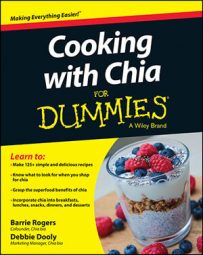Chia is one of the most nutrient-dense foods found anywhere in the world. Not only is it exceptionally high in essential nutrients such as protein and fiber, but chia benefits your health by giving you the vitamins, minerals, and antioxidants necessary for good health. Chia seeds have a lot to boast about, including their ease of use, long shelf life, and many more properties that make it a true superfood.
Chia is an excellent plant source of Omega-3 fatty acids
People everywhere are becoming more aware of the fact that they need omega-3 fatty acids for their brains to function well, their hearts to pump strong, and more. When it comes to plants, chia is one of the best sources of omega-3s.
Plus, because chia is a renewable resource — a plant that can be grown and harvested and replanted again — you can be confident that you aren’t diminishing the world fish supplies to get your omega-3 fix.
Chia is a complete protein
Chia seeds are a source of high-quality protein that your body needs to build and replace body cells. The protein in chia contains all nine essential amino acids, which makes it a complete protein. This is why chia is especially fantastic for vegans and vegetarians — finding a source of complete protein in the plant kingdom is difficult.
Chia has both soluble and insoluble fiber
Chia is high in fiber, but what gives chia the edge is that it has both soluble and insoluble fiber. Soluble fiber mixes with water, swelling to make you feel fuller longer. It also slows digestion and helps to balance blood sugar levels and lower cholesterol levels. Insoluble fiber doesn’t mix with water; it provides bulk in the diet, helping to keep you regular and prevent constipation.
Both types of fiber are essential for a balanced diet.
Chia is gluten-free
Many gluten-free foods contain unhealthy additives, undermining your efforts to choose healthy, gluten-free products. With chia, you get a naturally gluten-free food without the nasty additives. This means you can choose chia that’s packed full of essential nutrients while cutting down on processed gluten-free foods.
Chia absorbs liquids
Chia seeds are hydrophilic, meaning that when mixed with water or any other liquids, the seeds absorb the liquid and swell to up to ten times their size. This helps you feel fuller longer, helping you eat less and maintain a healthy weight. It also forms a physical barrier, slowing your body’s absorption of carbohydrates, which help to balance blood sugar levels.
This gives people who have diabetes a natural way to help manage their blood sugar.
Your body can easily absorb chia’s nutrients
The shells of chia seeds are very soft, so when you eat a whole chia seed, your body quickly breaks down the shell and easily absorbs all the nutrients contained within the shell. This is very different from other seeds high in omega-3s, such as flaxseeds.
Flaxseeds have very hard shells; when you eat them whole, your body can’t break down the shells, so the whole seed, with the precious omega-3s and other nutrients contained within it, just pass through the body undigested.
In order for your body to get the benefits from the nutrients in flax, the seeds must be broken down manually before being eaten — so you need to grind all flaxseeds or buy seeds that are already ground so your body can absorb the nutrients. That’s why chia is so great! You don’t need to grind them — your body can easily absorb the essential nutrients within chia’s soft shell.
Chia helps protect your heart
Not only does chia help reduce blood pressure, but it has been shown to reduce cholesterol because of its high concentrations of omega-3s. Chia has enough alpha-linolenic acid (ALA) to help maintain normal blood cholesterol levels, in addition to helping reduce the risk of cardiovascular disease.
Chia is easy to use
The subtle taste of chia seeds means that you can add it to all your favorite foods without affecting the taste, which makes it easy to use in everyday meals and snacks. You don’t need to cook chia seeds — in fact, they’re best eaten raw — so there is no preparation time. Simply toss some seeds into your foods to benefit from all chia has to offer.
Chia seeds have a shelf life of up to five years from harvest and can be kept at room temperature — no special storage requirements. This makes them convenient to keep for long periods of time. You can simply open a bag of chia, leave it on the kitchen table, and add it to everything — couldn’t be easier!
Chia is loaded with antioxidants
One of the unique properties that make chia seeds a superfood is the fact that chia is so high in natural antioxidants. These antioxidants help to reduce oxidative stress and help to prevent the onset of common degenerative diseases. People need to increase the amount of antioxidants in their diets, and chia can do just that with its high level of antioxidants found naturally.
It’s high in magnesium, selenium, and zinc
Chia is high in zinc, which helps the immune system and nervous system function well. Magnesium is needed for almost all body functions, and it’s also found in high quantities in chia seeds. Selenium, known for its role in thyroid and immune function, is found — you guessed it! — in chia.
All three of these nutrients are necessary for good health, and chia is a fantastic way to get them into your diet.

